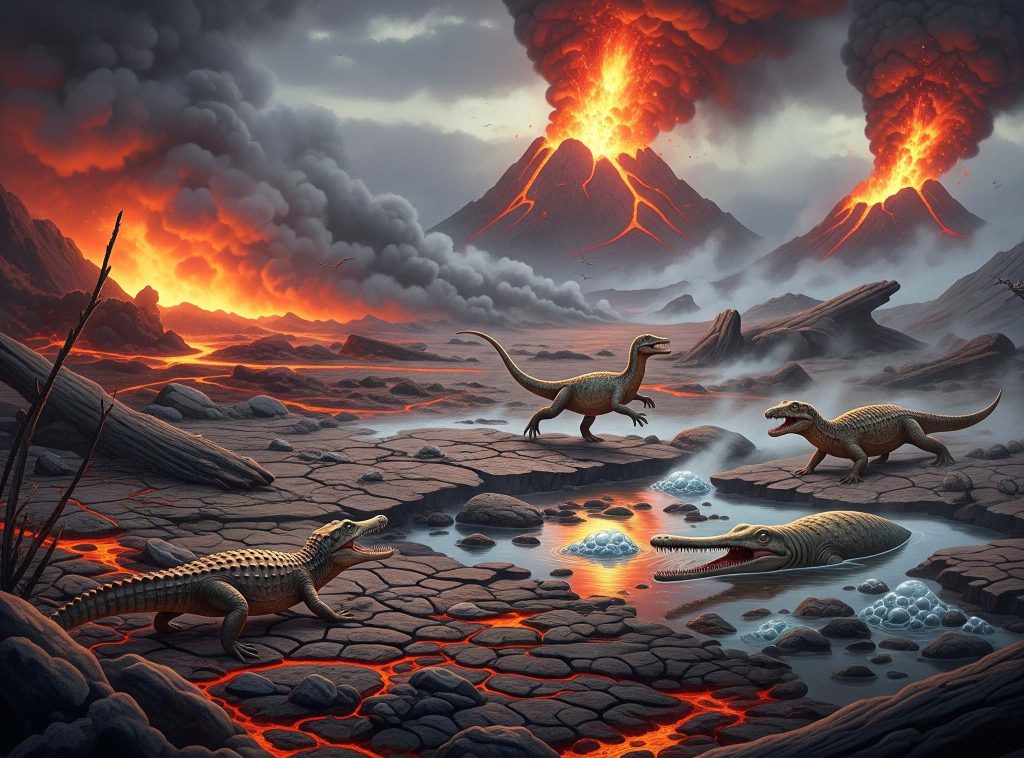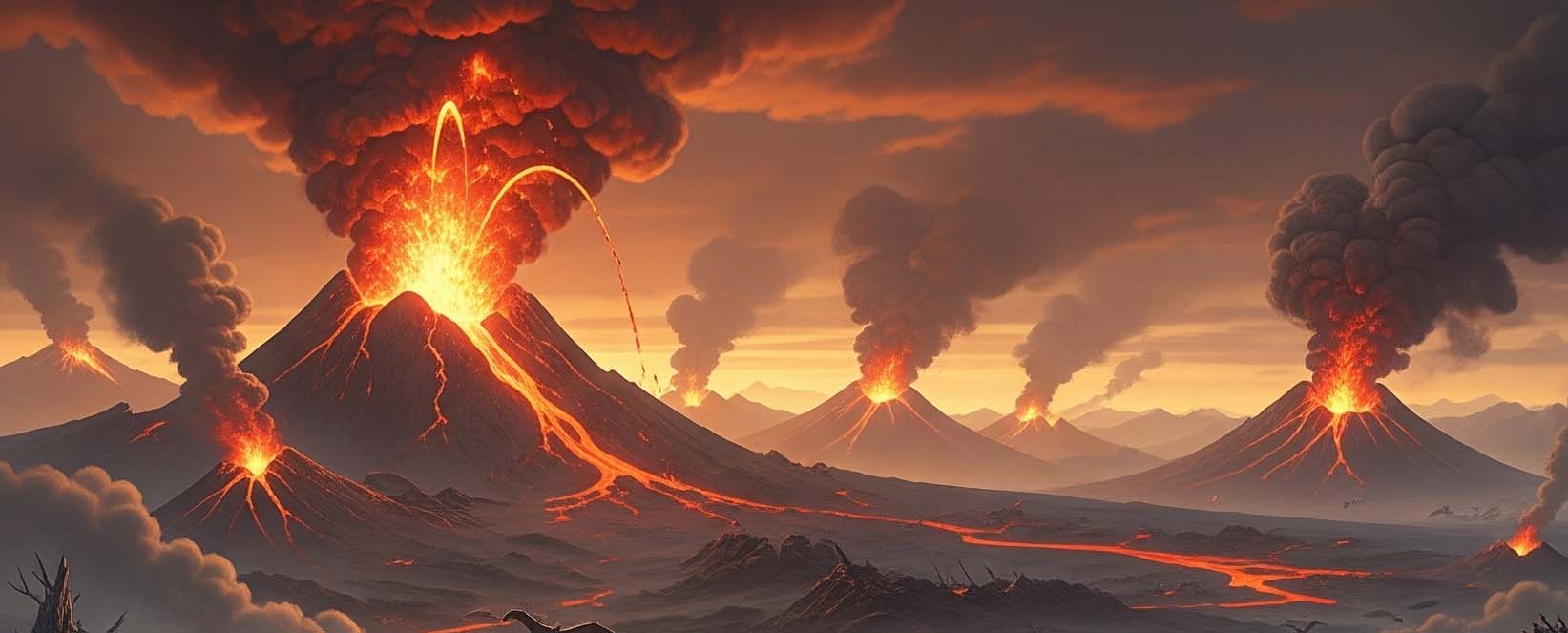Before the dinosaurs ruled the world, they were small, quick underdogs in the tough Triassic Period, sharing their home with much larger creatures called crurotarsans—giant, ancient crocodiles. But a catastrophic event reshuffled the deck, giving dinosaurs their big chance to rise.
Imagine you’re playing a game, and suddenly, all the strongest players on the other team disappear. That’s what happened to the crurotarsans. About 201 million years ago, the Earth experienced a massive shake-up known as the Triassic-Jurassic Extinction Event. While not as devastating as the “Great Dying” that preceded it, this event was a critical turning point for life on Earth and was the catalyst for the dawn of the dinosaurs.
Don’t Miss This!
After reading, challenge yourself with our interactive quiz at the end. Click here to take the Quiz
Index
This was the moment when the world hit a giant reset button, clearing the way for the dinosaurs to become the true kings and queens of the planet!

Earth’s Skin Cracks: The Giant Volcanoes Return
So, what caused this big disaster? Scientists believe it was mostly because of giant volcanoes erupting again, but this time, it was linked to something even bigger: the supercontinent Pangaea was starting to break apart!
Think of Pangaea like a giant, hard cookie. For millions of years, it was one solid piece. But deep inside the Earth, hot, gooey rock (magma) was pushing up, trying to break the cookie apart. When it finally started to crack, especially where the Atlantic Ocean is today, huge cracks opened up in the Earth’s skin. And what poured out of those cracks?
- Rivers of Lava: Not just little volcanoes, but massive, long cracks that spewed out lava for millions of years! This area is now called the Central Atlantic Magmatic Province (CAMP).
- Lots of Bad Gases: Along with the lava, these volcanoes released tons of gases into the air, like carbon dioxide.
These gases acted like a giant blanket around the Earth, trapping heat. This made the planet get even hotter, causing something called global warming. The oceans also got warmer and more acidic, which was really bad news for many ocean creatures. The climate became even more extreme, with crazy heat waves and changes in rainfall patterns.
Who Vanished and Who Stayed?
When the Earth gets this upset, not everyone can survive. This extinction event was very picky about who it affected. Here’s what happened:
- The Crurotarsans Disappeared: The big, scary, crocodile-like crurotarsans, who were the top predators and rulers of the Triassic world, were hit super hard. Most of them vanished forever! It’s like the strongest team in the game suddenly lost all their best players.
- Many Large Amphibians: Big, salamander-like creatures that lived in the water also struggled and mostly died out.
- Some Ocean Animals: Many types of sea creatures, especially those that couldn’t handle the warmer, more acidic water, also disappeared.
But guess who made it through much better? You guessed it – the dinosaurs! For some amazing reason, dinosaurs were much tougher and more adaptable to these big changes. Scientists are still figuring out exactly why, but here are some ideas:
- Better Breathing: Dinosaurs might have had a more efficient way of breathing, which helped them in a world with less oxygen or different air.
- Upright Posture: Walking with their legs directly under their bodies (like we do) might have helped them move around more easily and use less energy, especially when food was scarce.
- Finding New Food: Maybe they were better at finding new kinds of food when their usual meals disappeared.
It was like the dinosaurs had a secret superpower that helped them survive when almost everyone else was struggling!
The Empty Stage: Dinosaurs Take the Spotlight!
When the Triassic-Jurassic extinction was over, the world was a very different place. All those big, powerful crurotarsans were gone. This left a huge, empty space in the animal world, especially for big meat-eaters and plant-eaters. It was like the stage was set, but the main actors had left. And who was waiting in the wings, ready to step into the spotlight?
The dinosaurs!
With their biggest rivals gone, dinosaurs suddenly had a chance to grow, explore, and become super diverse. This is when the Jurassic Period began, and it’s the time when dinosaurs really started to become the giants we know and love. Here’s how they changed:
- Meat-Eaters Got Bigger: The small, two-legged hunters like Eoraptor and Herrerasaurus started to evolve into much larger, scarier predators. Think of dinosaurs like Allosaurus, a huge meat-eater with sharp teeth and claws, becoming the new top hunter.
- Plant-Eaters Became Colossal: The prosauropods, who were already plant-eaters, grew into the truly enormous, long-necked dinosaurs. These were the gentle giants like Brachiosaurus (who could reach leaves on super tall trees!) and Diplodocus (famous for its incredibly long neck and tail). They grew to sizes that are hard to imagine, munching on tons of plants every day.
- New Types of Dinosaurs: Many other kinds of dinosaurs started to appear, filling all the different roles in the ecosystem. Some learned to fly (pterosaurs, though technically not dinosaurs, they rose at this time), and others became armored tanks (like early stegosaurs).
The world itself started to change too. As Pangaea continued to break apart, new oceans formed, and the climate became a bit more stable in some areas. Lush forests of ferns, cycads, and conifers grew, providing plenty of food for the giant plant-eating dinosaurs. The Earth was becoming the “Age of Dinosaurs” that we often imagine.
A Lucky Break, or Built to Last?
So, the Triassic-Jurassic extinction wasn’t just a sad ending; it was a new beginning. It was a tough test for life on Earth, and the dinosaurs passed with flying colors. They were in the right place at the right time, with the right adaptations, to survive when others couldn’t. This big shake-up gave them the chance to take over and rule the planet for the next 135 million years!
From being small underdogs in a harsh world, dinosaurs became the dominant creatures on land, sea, and even in the air. Their story is a reminder that sometimes, even after the biggest challenges, new and amazing things can rise up and change the world forever.
Triassic-Jurassic Extinction Quiz
Test your knowledge about the event that allowed dinosaurs to rule the world!


Leave a Reply